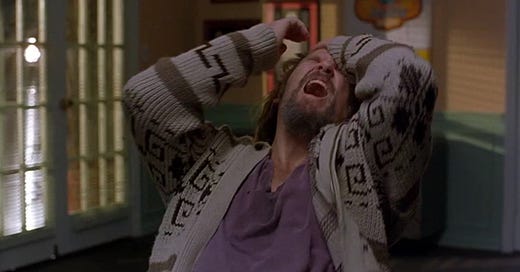American fascism will probably be the first which comes to power by democratic means and with democratic support. —Herbert Marcuse (1970)
I can understand why the term “fascism” sometimes feels emptied of content. It can become a meaningless, clanging way to say “This is bad” or “They are bad.” When the term is used by both Democrats and Republicans to describe political opponents, one might wonder whether the term means anything at all.1
I daresay this is a situation that fascists welcome. (“Just because you’re paranoid doesn’t mean they’re not after you,” as Kurt Cobain observed.) Evacuating the charge of “fascism” of any content, defanging the descriptor as just one more bit of partisan name-calling, amounts to an invisibility cloak for, you know, actual fascism. By turning “fascism” into an empty signifier, fascists can conveniently dismiss critics as hysterical alarmists.
The Life of a Concept
A big part of Alberto Toscano’s bracing book, Late Fascism, is a patient historical etymology of the term—what he calls the “aetiology of fascism.” He cautions the tendency to approach the issue by simply looking for analogies—like when we ask, “Is this fascism?” by trying to determine whether and how the situation today parallels 1920s Germany. Such an approach wrongly imagines that fascism is a static entity, when, in fact, fascism morphs. Which is also why anti-fascism must change with time and history. Hitler’s Germany or Mussolini’s Italy were fascist, of course, but neither is synonymous with some timeless “essence” of fascism, as if it was a Platonic form or an ideology with a simple checklist. If “fascism” is too tightly equated with these regimes, then reactionary forces can deflect the charge merely by showing dis-analogies.
Toscano’s point is that we can only meaningfully say fascism if we recognize it as a dynamic form of ideology and political strategy. So the first two chapters of Late Fascism track the term’s theoretical life from post-war realities (e.g., Bloch, Adorno) and then the critical development when it is appropriated by Black and decolonial liberation movements in the 1960s and 70s. The use of the term morphs in critical discourse to address the chameleon-like nature of the phenomenon itself. There is not “one” fascism. The development of an anti-fascist left continues to hone what “fascism” is. For example:
Black radical thinkers sought to expand the historical and political imagination of an anti-fascist left by detailing how what could be perceived from a European or white vantage point as a radically new form of ideology and violence was in effect continuous with the history of (settler-)colonial dispossession and racial slavery (28).
In other words, what arrives as “fascism” in Europe in the late 1920s and 30s has the features of a phenomenon that indigenous and enslaved peoples recognized as all too familiar. Or as Langston Hughes said in 1936: “Fascism is a new name for that kind of terror the Negro has always faced in America.”
So fascism does not always show up in the same way. It takes on new forms (hence the “late” fascism of the title). “Unlike classical European fascisms, US racial and settler-colonial fascism does not manifest univocally as the apotheosis of sovereignty, as a jackbooted Leviathan” (39). It can also appear “bottom-up” (this is what Paxton observes as unsettling today), de-centralized but encouraged by political actors like presidents and presidential candidates. Toscano quotes Nikhil Pal Singh:
[T]he Trump administration hardly needs organized paramilitaries to do its bidding, given the normative, historical, and institutional ways in which police powers in the United States operate as delegated and sovereign prerogatives to master and control indigenous and exogenous others.
We know exactly what this looks like.
Fascism is an ideology that feeds off crisis. So incoherence is a feature rather than a bug. Fascism is “a ‘scavenger’ ideology, scooping up ‘scraps of Romanticism, liberalism, the new technology, and even socialism,’” to create a Frankenstein political strategy. “Fascism was (and remains) able to weaponise a kind of structured incoherence in its political and temporal imaginaries, modulating them to enlist and energise different class fractions, thereby capturing, diverting and corrupting popular aspirations” (110).
Fascism seems to come from the outside, but it finds its energy right at the heart of everyone’s desire. —Felix Guattari
Family Resemblance
What, then, is the unifying germ that makes the term “fascism” applicable across diverse manifestations? A few aspects to highlight (folks should really read the book):
+Fascism is a form of “reactionary modernism” (not unlike religious fundamentalism) that feeds off nostalgia. Toscano unpacks the unique temporality of fascism. This quote is a little dense, but if you parse it, I think you’ll find this describes something very familiar today:
fascism mobilises non-contemporaneity (of identities, experiences, fantasies, and so on) around a nostalgic project of regeneration, palingenesis, rebirth, grounded in a view of the present as decadence, decay, degradation, consequent upon a defeat (99).
American translation: “Make America great again.” This quote is like the script for every rambling Trump rally. This is why fascism leverages a nostalgia “for the ‘Fordist’ heyday of Big Capital and Big Labour” (9)—the “reactionary trope of the abandoned working class” (21)—even while the policies of the fascist party are built to succor finance capital and global flows that escape state control.
+Fascism leverages the semblance of class (e.g., “white working class”) to mobilize a mere mass who, in the end, are convinced to support violence for the sake of sustaining capital. It is why prophets of deregulation like Ludwig von Mises welcomed the fascist state: it is the state scaled to a police function that allows private capital to roam like a devouring line. Quoting Daniel Guérin’s 1936 book, Fascism and Big Business, Toscano says “here lay the ‘vital difference’ between socialism and fascism when it came to the seizure of power: the former was the bourgeois state’s class enemy, ‘while fascism is in the service of the class represented by the state’” (59). This is why bereft workers from depleted Pennsylvania coal mines share a stage with Elon Musk.
This is also why fascists can happily talk of freedom (Toscano’s chapter on “Fascist Freedom” is probably the most original contribution of the book). Fascism is not the polar “other” of freedom; it is the apotheosis of freedom from a state that would impinge on property, capital, and individual selfishness. It is, in other words, more like the extension of Reaganism and Thatcherism than its antithesis. It is “state-led anti-statism” (58) which is the dream of oligarchs and billionaires. The “leader” of fascist movements is never really a “revolutionary;” instead, the leader is what Eric Fromm called an “authoritarian rebel” (62) who loves disruption and demolition as the milieu in which to concentrate his own power.
Large swaths of surplussed populations came to experience a vacillation of privilege whose libidinal correlate was not just a feeling of, but a desire for, social catastrophe.
+Psychologically, fascism feeds off individual’s “alienation from the dynamics and levers of capitalist power” (85). Fascism leverages a malaise that characterizes life under neoliberalism, particularly in the post-war abstractions of financial capital.2 Drawing on Adorno, Toscano’s marxist analysis merges with psychoanalysis to get at the psychological allure of fascism. “Large swaths of surplussed populations came to experience a vacillation of privilege whose libidinal correlate was not just a feeling of, but a desire for, social catastrophe” (88).
+Fascism is an erotics of power. Here is another aspect of fascism’s psychological allure: “power’s ‘erotic charge’” (139). It manifests in “the settler logic of petty sovereignty” (141); it licenses “the deputising of violence” (141). We just can’t underestimate how much alienated people—especially, but not only, men3—get off on this sort of exercise of a micro-power in the face of the grinding machinery of capitalism against which they are powerless.
+Fascism is reactionary precisely because it is counter-revolutionary. Fascism is an antidote to the possibilities of a socialist society. Fascism, paradoxically, feeds off the predation of capitalism, which is why it is a force in the service of capitalism rather than any supposed alternative. Toscano draws on Angela Davis to note that while “fascism is profoundly linked to a restructuring of the capitalist state, it is also fundamentally a counter-revolutionary form, manifesting in the violence with which it meets any substantive threat to the integrity of the state of capital” (33). Davis “develops the Marcusean thesis that ‘fascism is the preventive counter-revolution to the socialist transformation of society” (36). When MAGA gets riled by “socialism,” it is both a specter and a reality. Fascism is reactionary and anti-socialist, but the Democratic Party platform hardly represents “socialism” (I could only wish).
Fascism, Capitalism, Liberalism
Perhaps Toscano’s key critical point is this: fascism is not some monstrous “other” to liberal societies; it is, rather, a manifestation of hypocrisies within capitalist political economy that have been enshrined and secured by liberal states. Stop thinking about fascism in terms of “totalitarianism,” he urges, whereby we treat “fascism and liberalism as simple antonyms.” Instead, we need to recognize “the fascist potentials in neoliberalism” (65). Fascism is a virus latent in neoliberalism. Think of fascism not as some alien beast descending upon late modern societies, but instead as “the turbocharging of inherent traits of the neoliberal order” (72). This is why it is “facile” to imagine some intractable opposition between fascism and neoliberal democracy (37).
Fascism lives in the house capitalism built. “Late fascism is thus both a reaction against certain facets of the neoliberal moment (those that come to be coded and sometimes racialised as ‘globalist’) and a passionate over-identification with the coercive dimensions of the anti-state state [i.e., the minimalist state won by neoliberalism]” (72).4 Fascism “excels in the systematic manipulation of the serialities generated by capitalist social life” (18).
Thus Toscano cites Max Horkheimer’s enduring maxim (from 1939):
“Whoever is not willing to talk about capitalism should also be keep quiet about fascism” (75).
What this means is that we can’t happily imagine ourselves as anti-fascist if we happily give comfort to capitalism. To put this a little more uncomfortably: voting for the Democratic ticket (as I will be doing) does not grant one the luxury of a good conscience insofar as the Democratic platform does little to truly destabilize the concentration of global capital in the hands of a functional oligarchy. I’m all for progressive taxation, etc., but to truly build an anti-fascist society will require more radical measures. Every vote in a democracy is impure. I have no illusions, and in the face of the alternative, I will support the Democratic ticket as a penultimate strategy to hope for a society and world that exorcises the demon of fascism by realizing it has to behead the monster of finance capitalism.
Out and About
The good folks at the Christian Century have just published my essay, “Wisdom from Augustine in an election year.” The article began as a talk at the University of Texas earlier this spring and extends some of the insights in How to Inhabit Time.
If you’ll be attending the wild and wooly intellectual circus that is the American Academy of Religion, I’ll be part of a panel on Peter Harrison’s important new book, Some New World: Myths of Supernatural Belief in a Secular Age. While the book focuses on debates internal to the natural sciences in modernity, the scope of its argument is much wider—an original contribution to questions pursued by Charles Taylor and Hartmut Rosa.
Kind friends have put me onto two new bands that I am loving: Snail Mail and Local Natives.
For a long time, this was the posture of historian Robert Paxton. He has changed his mind.
At a recent conference, Jonathan Tran and Malcolm Foley both highlighted Bruce Rogers-Vaughn’s book, Caring for Souls in a Neoliberal Age.
Anyone who has heard of Lauren Boebert will see something recognizable in Toscano’s analysis of “fascist feminism” (148-150).
Rather than Leviathan, we get the “Behemoth” of the non-state (73).





